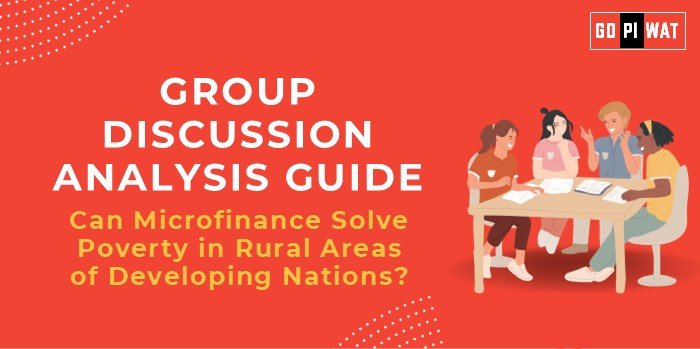📋 Group Discussion (GD) Analysis Guide
🌟 Can Microfinance Solve Poverty in Rural Areas of Developing Nations?
🌐 Introduction
Opening Context: Microfinance is often hailed as a revolutionary tool for economic empowerment, particularly in rural areas of developing nations, where traditional financial systems are inaccessible. Its potential to alleviate poverty, promote entrepreneurship, and foster social upliftment makes it a relevant topic for B-school aspirants.
Topic Background: Emerging in the 1970s with organizations like the Grameen Bank in Bangladesh, microfinance aims to provide small loans to individuals without collateral, particularly women. Recent discussions center around its effectiveness in transforming rural economies and addressing systemic poverty.
📊 Quick Facts and Key Statistics
- 🌍 Global Microfinance Outreach: Over 140 million borrowers globally, 85% of whom are women (World Bank, 2023).
- 💵 Loan Repayment Rates: 95%-98% repayment success in developing nations (CGAP, 2023).
- 📉 Poverty Reduction: 10% average reduction in poverty levels in regions with strong microfinance networks (IMF, 2023).
- 📈 Economic Empowerment: 74% of microfinance beneficiaries engage in income-generating activities within six months of receiving loans (UNDP, 2023).
🤝 Stakeholders and Their Roles
- 💼 Microfinance Institutions (MFIs): Provide financial services and support entrepreneurial ventures.
- 🏛️ Governments: Facilitate policies and subsidies for microfinance programs.
- 🌐 International Organizations: Support funding and best practices, e.g., World Bank, UNDP.
- 👩👩👧👦 Local Communities: Act as both beneficiaries and influencers in adoption rates.
- 🏠 Non-Governmental Organizations (NGOs): Provide training and promote financial literacy.
🏆 Achievements and Challenges
✔️ Achievements:
- 👩🦰 Empowerment of Women: 85% of loans provided to women, leading to increased social and economic independence.
- 📋 Job Creation: Millions of small-scale businesses have been initiated.
- 🌱 Social Inclusion: Enhanced access to education and healthcare via income growth.
- 🌍 Global Success Stories: Bangladesh (Grameen Bank), India (SHG-Bank Linkage Program).
⚠️ Challenges:
- 💰 Debt Cycles: High-interest rates sometimes exacerbate poverty.
- 📉 Limited Outreach: Remote areas still underserved.
- 📊 Dependency: Overreliance on loans without sustainable growth plans.
- 🌍 Global Comparisons: Kenya’s success with mobile banking via M-Pesa contrasts with limited microfinance penetration in Sub-Saharan Africa.
🗣️ Structured Arguments for Discussion
- 👍 Supporting Stance: “Microfinance has empowered rural women, transforming economies by fostering entrepreneurship and reducing poverty levels.”
- 👎 Opposing Stance: “High-interest rates and over-indebtedness highlight microfinance’s limitations in addressing structural poverty.”
- ⚖️ Balanced Perspective: “While impactful, microfinance must be complemented by financial literacy, infrastructure development, and policy reforms to ensure sustainable poverty alleviation.”
✨ Effective Discussion Approaches
- 📖 Opening Approaches:
- Start with a global success story: “Grameen Bank’s role in Bangladesh’s poverty reduction.”
- Present a critical statistic: “With a 95% repayment rate, microfinance stands as a resilient model for inclusive development.”
- 🛡️ Counter-Argument Handling:
- “While high-interest rates are a concern, regulatory frameworks can cap rates, ensuring borrower protection.”
- Use data-backed rebuttals using regional success cases.
📈 Strategic Analysis (SWOT)
- 💪 Strengths: High repayment rates, women’s empowerment.
- 🛠️ Weaknesses: Limited outreach, risk of debt traps.
- 🌍 Opportunities: Integration with digital platforms, partnerships with fintech.
- ⚠️ Threats: Regulatory challenges, market saturation.
📚 Connecting with B-School Applications
- 🔗 Real-World Applications: Potential themes for projects in microfinance integration with tech, policy design, or rural development.
- ❓ Sample Questions:
- “How can microfinance be scaled sustainably in rural economies?”
- “What role does financial literacy play in the success of microfinance?”
- 💡 Insights for Students: Explore microfinance’s intersection with social impact investing or corporate social responsibility (CSR) initiatives.


